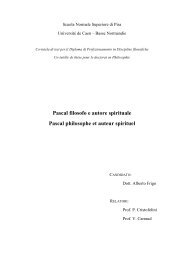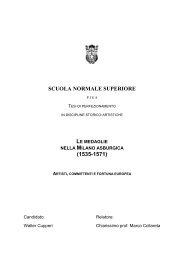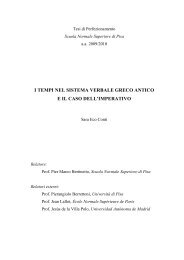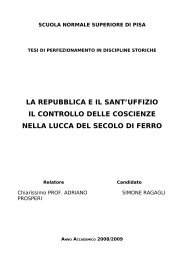CATULLUS 68 - Scuola Normale Superiore
CATULLUS 68 - Scuola Normale Superiore
CATULLUS 68 - Scuola Normale Superiore
Create successful ePaper yourself
Turn your PDF publications into a flip-book with our unique Google optimized e-Paper software.
incommoda, pessimi poetae, 43.8 o saeclum insapiens et infacetum!, 78b.3f. te omnia saecla / noscent et qui<br />
sis, fama loquetur anus and 95.6 Zmyrnam cana diu saecula peruoluent. This connection seems to have been<br />
commonplace: thus also Cinna frg. 14 FPL 3 saecula permaneat nostri Dictynna Catonis, Cic. Div. 1.36 hos<br />
… mentiri iudicemus nec saeculorum reliquorum iudicium quod de ipsis futurum sit pertimescere (on the<br />
authors of astrological works), Lucr. 3.629f. pictores itaque et scriptorum saecla priora / sic animas intro<br />
duxerunt sensibus auctas and Quint. 10.1.92 dicent haec plenius futura saecula (they should pass judgement<br />
on the Emperor Domitian’s literary talents).<br />
While the word is often written in the MSS as sec- rather than saec- (thus the OLD), the correct form is<br />
surely the latter: CIL 10.1401.6 (A.D. 44/46) writes SAECVLI and the word is related to Gallic hoedl ‘life-<br />
time, life’ (Ernout-Meillet). Here Catullus is using the anaclastic form saeclum, which he prefers to saeculum<br />
(he uses the former 6x, the latter 1x), as do other Republican poets (Pl. 3x against 1x, Ter. 2x against 0x and<br />
most conspicuously Lucr. 45x against 0x; Caec. Stat. and Cic. 1x against 0x; only in Cinna 0x against 1x ).<br />
saeculum is the only form found in prose, apart from Cicero’s rhetorical and philosophical works (15x<br />
saeclum alongside 30x saeculum). From the Augustan period onwards the anaclastic form is gradually<br />
eliminated even in poetry: Propertius has saeclum 3x against saeculum 2x, Virgil 5x against 9x, Ovid 3x<br />
against 21x, Silius 6x against 21x and Valerius Flaccus 2x against 4x. Horace, Tibullus, Manilius and Lucan<br />
only use the longer form.<br />
Note the archetype’s error sedis: it must result from the misreading of a minuscule MS, in which cl<br />
resembled d. The mistake was already corrected by the scholar who copied MS β (78, that is, the famous<br />
Codex Traguriensis) for his own use, as he added seclis in the margin as a variant some time after copying<br />
the text.<br />
44 caeca nocte Catullus picks up Accius trag. 33 deum regnator nocte caeca caelum e conspectu abstulit,<br />
a stark phrase that was imitated similarly by Lucr. 1.1115f. nec tibi caeca / nox iter eripiet, Verg. Aen.<br />
2.397f. multaque per caecam congressi proelia noctem / conserimus and Geo. 3.260 and directly or through<br />
Virgil’s mediation also at Ciris 523, Ov. Met. 6.472f., 10.476 and 11.521, Sen. Oed. 1049 and Thy. 6<strong>68</strong>,<br />
Lucan 4.244 and 10.506, Sil. 10.538f. and 13.254 and a number of Christian authors: see TLL 3.44.72-77.<br />
The present passage is probably echoed by Ovid Tr. 3.6.31f. quaecumque adeo possunt adferre pudorem, /<br />
illa tegi caeca condita nocte decet. Here caeca is passive and means ‘obscure’, as at 64.207f. caeca mentem<br />
caligine Theseus / consitus; see further OLD s.v. 5a and TLL 3.44.70-45.44. For nox ‘darkness’ compare<br />
51.11f. gemina teguntur / lumina nocte.<br />
49f. As so often in Catullus, an abstract phenomenon is rendered palpable through an image drawn from<br />
real life. The use of cobweb imagery to characterize neglect is conventional: cfr. Od. 16.34f. Οδυ!!°ο! δϒ<br />
που ε⎡ν↓ / ξ→τει ⁄νευνα⇔ϖν κ κ ρ ξνια κε⇑ται ⁄ξο⎝!α and Theocr. 16.96f. ρ ξνια δ∋ ε⇒! ⎟πλ<br />
ρ ξναι / λεπτ δια!τ→!αιντο. In the present image Allius’ name has been inscribed somewhere,<br />
probably not onto “a statue or bust identified by a titulus” (Clauss 1995: 240) but rather onto a funerary<br />
158






